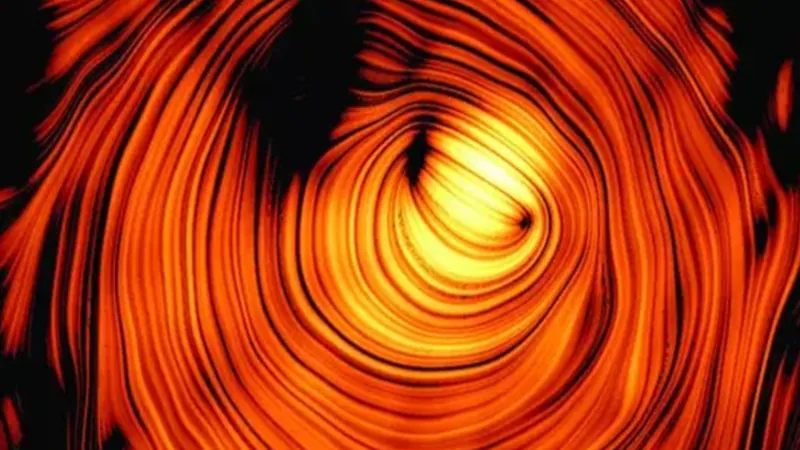
Giant Cosmic 'Eye of Sauron' Gazes from the Depths of Space in Jaw-Dropping 15-Year Snapshot
2025-08-15
Author: Siti
Astronomers have unveiled a breathtaking image of a colossal energy jet, nicknamed the "Eye of Sauron," staring directly at Earth. This remarkable snapshot is the culmination of a staggering 15 years of observations, offering new insights into the elusive origins of neutrinos—mysterious particles that rarely interact with other matter.
The source of this glaring cosmic eye is the blazar PKS 1424+240, located billions of light-years away. A blazar is a powerhouse quasar, featuring a supermassive black hole at its core, unleashing enormous energy jets that shoot into space at nearly the speed of light. These jets are rich in high-energy gamma rays and X-rays, making them among the universe's brightest phenomena.
Blazars have a particular advantage: their energy jets are almost perfectly aligned with Earth. This direct alignment means we receive their radiation head-on, causing them to appear significantly brighter than other quasars, often outshining their host galaxies.
Using radio waves, researchers examined one of PKS 1424+240's "jet cones," enabling them to visualize the magnetic fields within the jet. Discovered as a radio source in the 1970s and officially classified as a blazar in 1988, PKS 1424+240 is unique. Its jet is angled at less than 0.6 degrees toward us, a configuration that has only now been mapped accurately.
In a groundbreaking study published on August 12 in the journal Astronomy and Astrophysics, researchers presented the first detailed image of PKS 1424+240, pieced together from 15 years of data collected by the National Radio Astronomy Observatory's Very Long Baseline Array (VLBA), which unites the power of 10 radio dishes across the U.S.
Yuri Kovalev, the study's lead author from the Max Planck Institute for Radio Astronomy in Bonn, Germany, expressed amazement at the results: "When we reconstructed the image, it was absolutely stunning. We have never seen anything quite like it—a near-perfect toroidal magnetic field with a jet pointing straight at us."
The image's clarity owes much to the jet's alignment with Earth, which magnifies its energy emissions through the effects of special relativity, making it approximately 30 times brighter than it would be otherwise.
The researchers aptly named the image the Eye of Sauron due to its resemblance to the iconic logo from J.R.R. Tolkien's "The Lord of the Rings". Interestingly, this isn't the first scientific discovery inspired by this fictional entity; a giant underwater volcano in the Indian Ocean and a new Amazonian piranha species have also shared the moniker.
Curiously, PKS 1424+240 holds a significant position in the realm of neutrinos, being the brightest known neutrino-emitting blazar. These elusive "ghost particles" zip through the universe, rarely interacting with ordinary matter, yet trillions pass through our bodies every second.
Detecting neutrinos is a challenge, usually accomplished through massive underwater detectors or particle colliders on Earth. Their enigmatic nature pushes scientists to explore cosmic phenomena like PKS 1424+240 for answers.
By visualizing the magnetic field driving the jet, researchers have taken a significant step towards understanding the blazar's inner workings. They hypothesize that the magnetic field accelerates protons to astonishing speeds, eventually converting them into neutrinos. However, further observations of similar jets will be necessary to fully unravel this cosmic mystery.





 Brasil (PT)
Brasil (PT)
 Canada (EN)
Canada (EN)
 Chile (ES)
Chile (ES)
 Česko (CS)
Česko (CS)
 대한민국 (KO)
대한민국 (KO)
 España (ES)
España (ES)
 France (FR)
France (FR)
 Hong Kong (EN)
Hong Kong (EN)
 Italia (IT)
Italia (IT)
 日本 (JA)
日本 (JA)
 Magyarország (HU)
Magyarország (HU)
 Norge (NO)
Norge (NO)
 Polska (PL)
Polska (PL)
 Schweiz (DE)
Schweiz (DE)
 Singapore (EN)
Singapore (EN)
 Sverige (SV)
Sverige (SV)
 Suomi (FI)
Suomi (FI)
 Türkiye (TR)
Türkiye (TR)
 الإمارات العربية المتحدة (AR)
الإمارات العربية المتحدة (AR)